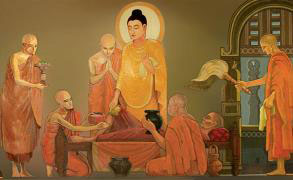Colombo, Sri Lanka — The Buddha encouraged his disciples to look after the sick. The Blessed One made this famous statement “He who attends the sick attends me,” when he discovered a desperately ill monk with an acute attack of dysentery, lying in his grubby robes. On this occasion the Buddha with the help of Ananda Thera washed and cleaned the sick monk with warm water. He said that it is the responsibility and duty of the community to look after the sick.

The Buddha expounded the real qualities that should be present in a caregiver – competence to dispense the medicine, be thorough of what is agreeable and disagreeable to the patient and refraining from giving what is disagreeable. A caregiver should also be compassionate, kind and should not be repulsed by saliva, phlegm, urine, stools or sores. The caregiver should be able to stimulate the patients with good bedside manner.
Kindness
When one is severely sick apart from providing proper food and medicine, it is important to take care of the mental conditions as well. As such kindness of doctors and nurses is as important as effective medicine to a speedy recovery. Thus kind words and acts are helpful in bringing in hopes and comfort to a helpless patient. Metta and Karuna are sublime emotions (brahamavihara).
Sickness is a period where one faces the realities of life and the fear of death is naturally greater when a person is sick than when one is feeling well. Diverting one’s attention to Dhamma is the best remedy of calming the fear and caregivers are expected to help patients to turn to spiritualism.The Buddha describes three types of patients in Anguttara Nikaya – those who do not recover whether they do get or do not get the proper medical attention and care; those who recover irrespective of whether or not they get medical attention and care and those who recover only with suitable medical treatment and care. However, as long as a patient is alive, everything possible should be done with best medical treatment available and suitable food and care for his or her recovery.
In other Suttas too the Buddha has explained that illness is inevitable in life. In such instances people do whatever possible to restore good health. Though it is not incorrect to do so in such crisis those attempts should not disagree with the conscience of a person. Death might occur in spite of those attempts where one has to accept it with self-control and rational mind as a result of kamma.
Advance spirituality
The Buddha has showered the sick with great compassion and understanding. In the Dhammapada it is explained that health is the best benefit (Aarogya Parama Labha) and the Buddha has laid several minor disciplinary rules to adapt to the requirements of sick monks.The Buddha has used great will power and self-control when he fell ill. The Buddha when he fell ill last had courage to walk from Pava to Kusinara with Ananda Thera, while resting in a number of places. One spiritually developed should be capable of maintaining good mental health proportionate to his spiritual development.
Recitation of the enlightenment factors (Bojjhanga) is useful in healing physical ailments. When Mahakassapa and Mahamoggalllana were sick, the Buddha recited the enlightenment factors and they had regained good health. It is reported in Bojjhanga Samyutta that when the Buddha was ill, he requested Cunda to recite the enlightenment factors and Buddha regained good health.
– Read more : www.buddhistchannel.tv




